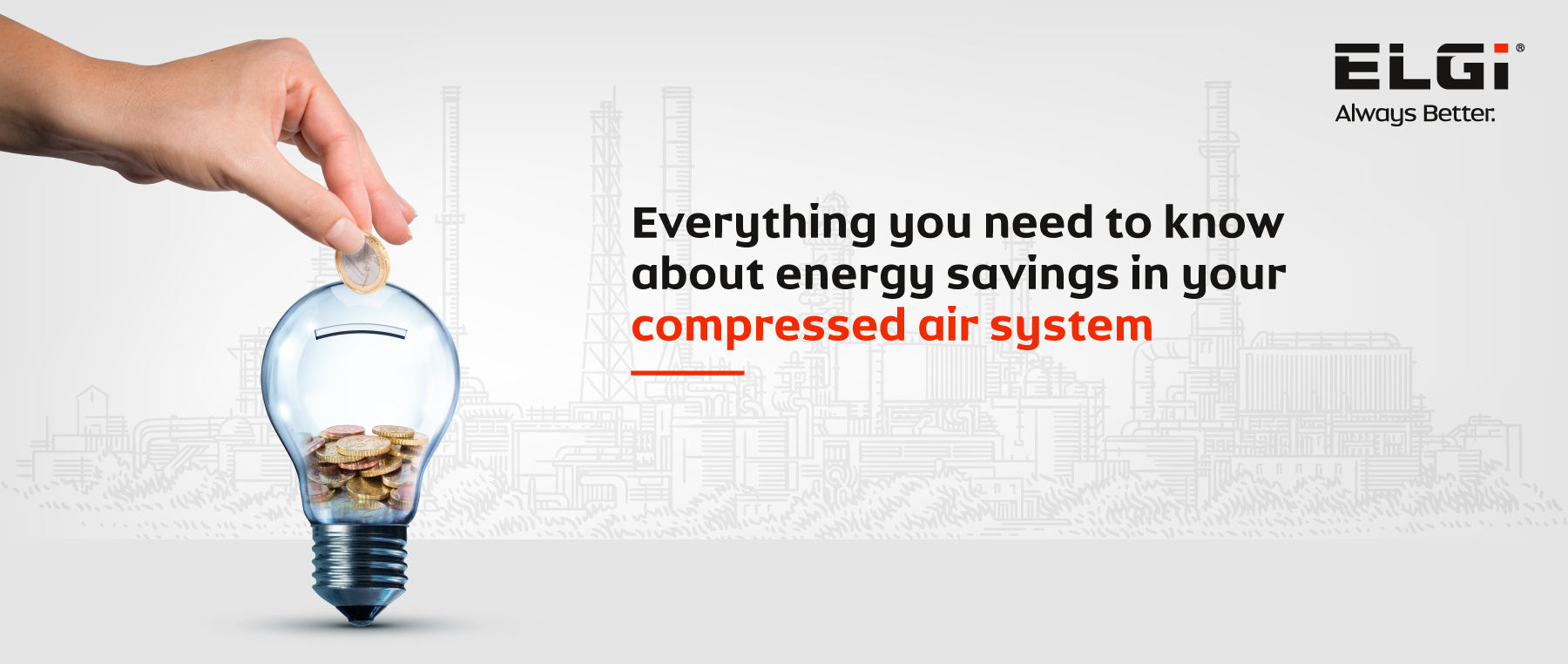Importance: In the life cycle cost of a compressor, energy cost is the major contributor and even little savings in the energy consumed by the compressor will result in considerable cost savings to the customer.

Factors affecting energy consumption: Following are the major factors affecting the energy consumption of a compressor
1. Selection and sizing of compressor
2. Selection of air accessories
3. Piping layout
4. Operating pressure
5. Delayed maintenance
6. Artificial demand
7. Leakage
8. Managing multiple compressors operation
9. Heat of compression
Now let’s discuss the above factors in detail.
Selection and sizing of compressor: It is very critical to select the right type and right capacity of the compressor during the initial plant setup. For example, selecting a lubricated compressor and installing downstream filters to remove the oil particles instead of selecting an oil-free compressor will result in energy loss due to pressure drop across the downstream filters which can be avoided. Similarly, oversized (higher capacity) compressors will run in unloading conditions for longer durations and will waste energy.
Selection of air accessories: The selection of the right accessories for the air compressor plant plays a vital role in reducing the energy of the compressed air system. The size and type of downstream filters, dryers and receivers if not carefully selected, will lead to excessive power consumption and hamper the production process.
Lower sizing of downstream filters à Excessive pressure drop and power consumption
Lower sizing of refrigerant dryers à Excessive moisture carryover, disturb the production process and may damage the user end equipment and machinery
Higher sizing of desiccant dryers à Excessive purge loss and power consumption
Undersized storage receivers à Increased energy cost on load/unload compressors.


Piping layout:
The design of the piping layout has a long-time effect on the compressed air system. Inefficient design of the piping layout will lead to excessive pressure drop, and increased leakage and in turn will result in the energy cost of the compressed air system shooting up over the period. It will be advisable to consider the below factors while designing the compressed air piping layout.
- Piping material (Aluminium or plastic instead of MS/GI pipes)
- Piping layout (looped or non-looped)
- No. of joints, bends, elbows, and Tees
- Welded or o’ring joints instead of threaded joints
- Diameter of the main header/sub headers
Operating pressure: Operating the compressor at higher pressure than the pressure required for the end user, will increase the energy bill of the compressor substantially. As a thumb rule, in the systems operating at 7 bar pressure, every one bar increase in the operating pressure will increase the energy consumption by 7%. It will be prudent to set the compressor load and unload pressures considering the requirement of the end user and the estimated pressure drop between the compressor and the pressure required at the farthest point of the application.
Delayed maintenance: Timely maintenance of the compressor and replacement of consumables and other maintenance kits as per the recommended maintenance schedule of the OEM will go a long way in ensuring the trouble-free operation and efficient performance of the compressor. Delaying the maintenance of the compressor and not replacing the consumables like an air filter, oil filter, air/oil separator element and the coolant/lubricant on time will increase pressure drop across these filters and in turn, increase the energy consumption and reduce the capacity of the compressor.
The table below shows the impact of the delay in the replacement of the consumables for a 75 KW compressor.

Artificial Demand: It is the increased compressed air consumption of the system due to operating at higher than necessary operating pressure. Unregulated compressed air use, leakage, blowing applications, tools, air motors, pneumatic cylinders etc. all consume more compressed airflow as system pressure increases. Air demand increases by 2 % for each 2 psi increase in operating pressure. Artificial demand can be reduced by reducing the operating pressure and by setting the compressor load/unload pressures at the optimum range.
Leakage: Leaks in a compressed air system can waste your operating budget on high electricity consumption every year. In many manufacturing and processing plants, the leakage can account for up to 20% of the total energy cost of the compressor. The most common areas where you might find leaks are connection joints like valves, unions, couplings, fittings, etc. This can also cause the compressed air system to lose pressure which reduces the efficiency of the pneumatic tools or machines that make use of compressed air in the system like an air-operated actuator being unable to close a valve, for instance, and may cause rejections in the end product.

One simple way to estimate how much leakage a system has is to turn off all of the point-of-use devices / pneumatic tools, then start the compressor and record the average time it takes for the compressor to cycle on and off. The total percentage of leakage is calculated as follows:
% Percentage = [(T x 100) / (T + t)] where T = on time in minutes, t = off time in minutes
The percentage of the compressor’s capacity that is lost should be under 10% for a system that is properly maintained.
Multiple Compressors Operation: An unmanaged control scheme for a bank of air compressors is a recipe for unnecessary consumption of power, as well as increased or unplanned maintenance and can cause one or more of the following problems:
- Too many compressors are running.
- The wrong combination of compressors is running.
- Pressure is higher than it needs to be.
When a rotary screw compressor is running unloaded, it will still consume about 30% of its full load power, but since it is producing no air, this wastes power if the run time is unnecessary.
For systems with more than three compressors, it is usually necessary to implement some sort of automatic control using a compressor controller. This is because the higher the number of compressors, the wider the total system pressure band will be, eventually exceeding the compressor pressure ratings.
Typical controllers communicate with all the system compressors and choose the best compressors to run at any one time, depending on a control algorithm and operator input. Most often, the controller will run the compressors in a single pressure band arrangement that will keep the pressure within a narrower and lower band. Most controllers will incorporate any variable speed compressors.
Running with lower pressure reduces the average compressor power consumption. Running only one trim compressor minimizes wasteful unloaded run time. With any system, an adequate amount of storage receiver capacity needs to be installed—the typical size required is between 2 to 4 cubic metres per 100 cfm rating of the largest trim compressor.
Many modern compressors already have sequencing control built into the onboard controls; if your system is newer, you should look into this possibility. If you are concerned about your compressor control and would like to improve it, contact your compressor service provider to come to have a look at your system. Your supplier may have a control system solution to help solve your problems.

Heat Recovery Systems: It is a surprising fact that 100% of the electrical power (energy) is converted to heat energy during the compression process in an air compressor and all the heat energy goes waste if not used judicially.
In a typical compression system, the theoretical recoverable heat is 96% of the overall electrical energy consumption. It consists of heat dissipated in the oil cooler (78%) the aftercooler (13%) and the heat radiated from the drive motor (5%). The rest 4% of heat cannot be recovered since 2% radiates through the canopy and the other 2% vents inside the canopy.
Keeping in mind the effects of global warming in the present environment, it is recommended that using a heat recovery system 76% of the waste heat generated from the compressor can be utilized for heating air (space) and heating water. This in turn eliminates the necessity to go for additional equipment to heat water or air, thereby reducing the CO2 emission to a larger extent.
Schematic Diagram of Heat Recovery Unit

With increasing energy costs, the performance and efficiency of your compressed air systems have never been more important. ELGi’s Air audit may help users identify potential opportunities for energy savings in their compressed air system and thereby reduce the total operational cost. Our Audit Report includes identifying all the big, medium, and small opportunities for energy savings in the compressed air system and providing recommendations on short, medium, and long-term measures for energy conservation, along with financial estimates and analysis for their implementation. The audit involves a wide range of sophisticated, portable diagnostic and measuring instruments to generate refined data and facilitate complex analysis to give a more reliable basis for identifying energy-saving opportunities, evaluating performance, energy-saving measures, and economic viability. In addition, ELGi’s Air audit will benefit customers by reducing the wear, tear, and maintenance costs during the lifetime of the entire compressed air system.




